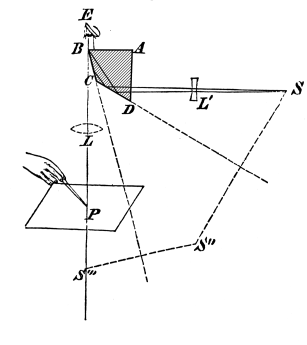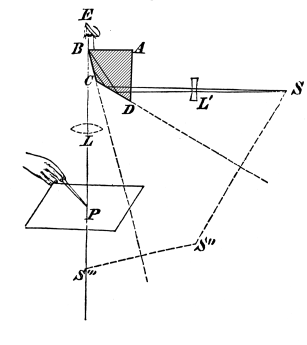The camera lucida performs an optical superimposition of the subject being viewed upon the surface upon which the artist is drawing. The artist sees both scene and drawing surface simultaneously, as in a photographic double exposure. This allows the artist to duplicate key points of the scene on the drawing surface, thus aiding in the accurate rendering of perspective.
-
Camera lucida – Wikipedia, the free encyclopedia
-
Camera lucida – Wikipedia, the free encyclopedia
The camera lucida performs an optical superimposition of the subject being viewed upon the surface upon which the artist is drawing. The artist sees both scene and drawing surface simultaneously, as in a photographic double exposure. This allows the artist to duplicate key points of the scene on the drawing surface, thus aiding in the accurate rendering of perspective.
-
Camera lucida – Wikipedia, the free encyclopedia
The camera lucida performs an optical superimposition of the subject being viewed upon the surface upon which the artist is drawing. The artist sees both scene and drawing surface simultaneously, as in a photographic double exposure. This allows the artist to duplicate key points of the scene on the drawing surface, thus aiding in the accurate rendering of perspective.
-
Camera lucida – Wikipedia, the free encyclopedia
The camera lucida performs an optical superimposition of the subject being viewed upon the surface upon which the artist is drawing. The artist sees both scene and drawing surface simultaneously, as in a photographic double exposure. This allows the artist to duplicate key points of the scene on the drawing surface, thus aiding in the accurate rendering of perspective.
-
Wim T. Schippers – The floating stone – 1999
Wim T. SchippersThe floating stone1999Modern artIn his work ‘Het is me wat’ [Well I never], Wim T. Schippers appears to defy the forces of gravity: a stone hovers above a plinth. Schippers worked with the Technical University in Delft to achieve this. The stone can defy gravity thanks to three electromagnets that exert force on magnets incorporated in the floating stone. The words ‘Het’, ‘Is’, ‘Me’ and ‘Wat’ are written on the four sides of the plinth. Schippers designed this work for the Ministry of Heath, Welfare and Sport, where it was unveiled on 16 December 1999. Since 2005, the art work has been housed in Boijmans Van Beuningen Museum. Website of the artist
-
2 versions of Timekeeper by Pierre Huyghe.
-
Creating Printing Plates with Laser Toner – Part 1 – YouTube
-
MassArt Film Society: 9/15/2010 Sandra Gibson and Luis Recoder
-
Gibson, Recoder, Block on Vimeo
http://vimeo.com/22250468
-
Pressure + Ink: Introduction to Printmaking – YouTube
[youtube http://www.youtube.com/watch?v=-BYHn5Vum_A?list=PLD1240D899F3875A4&w=560&h=315]
Got any book recommendations?






